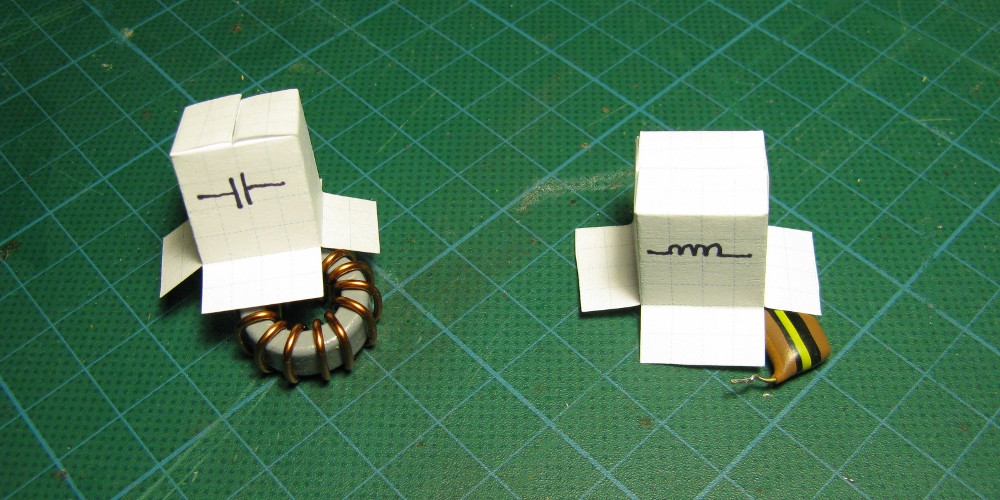"Mutator: The Chameleon Black Box
[... It] is possible to produce a mutation from one species [of the three basic network elements, resistors, capacitors, and inductors] into another another with the help of a two-port black box called the mutator. For example, it is possible to connect a resistor across port 2 of a mutator and produce an inductor across port 1. Conversely, if an inductor is connected across port 1 of the same mutator, a resistor is produced across port 2. For this reason, this class of mutators is called R-L mutators. The two other classes are the R-C mutators and the C-L mutators. An R-C mutator transforms a resistor into a capacitor, and vice versa. Similarly, a C-L mutator transforms a capacitor into an inductor, and vice versa."
(From Chua's book Introduction to Nonlinear Network Theory, McGraw-Hill, 1969, p.138)
Fig. 1 in the paper by Chua that you provided a link to, published in 1971, also shows what a mutator does and extends the concept to the memristor - the fourth basic circuit element: It is an active circuit that uses a known circuit element and mutates it into one that has memristive properties. (Known as of the paper's publishing date - today, HP has discovered something memristive.) This may still sound a bit confusing, so let's do a little detour.
You can use a gyrator when you need an element that behaves like an inductance, but all you have available is a capacitor. You pay for this "magic" with the cost of an active circuit (read: transistors, tubes, ...). A practical example for this may be integrated design: Transistors are almost free, and it's possible to build capacitors on silicon, but you can hardly wind inductors on a chip - except extremely tiny ones for very, very high frequencies. Also, inductors for audio filters often would have to be fairly large, both in Henries and in physical size; this is why you will find gyrators or (somewhat inaccurately named) solid state inductors1) on the internets. Using a gyrator, you can use a capacitor and transmogrify ("mutate", maybe even "gyrate"2)) some of its its properties into one of an inductor3). You could also go the other way round; wind an inductor and use a gyrator to obtain a capacitive circuit element (although this will hardly ever be a practical and cost-effective solution). A gyrator, in this example, and using the words from Chua's paper on memristors, would thus be something like a mutator between capacitors and inductors.
Anyone familiar with Calvin and Hobbes will, I am sure, appreciate this picture. It shows two gyrators in the shape of transmogrifiers; one makes an inductor behave like a capacitor, the other one makes a little 100 nF ceramic capacitor act like an inductor.

Now back to the memristor. Until recently, when an element with memristive properties was developed by Hewlett-Packard, you had not only the trouble of not being able to use memristors in certain processes (like IC design) - you had no memristors at all. Thus, the memristor shown in fig. 1a of Chua's paper was plain theory. The only way to get something memristic onto the screen of an actual curve tracer was using a known element like a (nonlinear) resistor (fig. 1b), a (nonlinear) inductor (fig. 1c) or a (nonlinear) capacitor (fig. 1d), and to put it through a circuit that would mutate its properties into those of the proposed memristor.
In Chua's paper, fig. 1 shows three types of black-box-like, two-port mutators. Fig. 2 shows a practical circuit that gives you a memristic behaviour looking into port 1 when you offer a (nonlinear) resistive element on port 2, say a resistor (linear) or a diode (nonlinear resistive). Therefore, fig. 2 would be a more detailed view into the black box of fig. 1b.
Aside from fig. 2 in Chua's paper, here are some other examples that show what practical implementations of mutators might look like:

From left to right: A 1N4148 diode (nonlinear resistive element) acts like a memristor (similar to figs. 1b or 2 in the paper), an inductor transmogrified into a memristor (Chua: Fig. 1c), and a 100 nF ceramic capacitor transmogrified into a memristor (Chua: Fig. 1d).
I have to admit that the examples in the pictures are non-perfect: They are white-box models instead of the original black-box models. Other that that, I promise that they actually do work! As a proof, screenshots taken with my Tek 575 curve tracer will follow ;-)
1) I have actually never seen a non-solid inductor. Gas? Liquid? Plasma? Only when a solid inductor blows, but that's on the odd side of reasoning. I guess calling these gyrators transistorized would be less misleading.
2) see here for a well-known, cardboard-box-like, real-world (!), non-electronic (?) transmogrifier. As the cited source says, when it comes to transmogrification, "Scientific Progress Goes 'Boink'" - use with caution!
3) See this question about energy storage in a gyrator for some hints on a gyrator's limitations.


